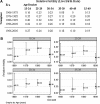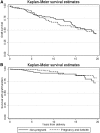Pregnancy and maternal outcomes among kidney transplant recipients
- PMID: 19797167
- PMCID: PMC2799176
- DOI: 10.1681/ASN.2008121241
Pregnancy and maternal outcomes among kidney transplant recipients
Abstract
Fertility rates, pregnancy, and maternal outcomes are not well described among women with a functioning kidney transplant. Using data from the Australian and New Zealand Dialysis and Transplant Registry, we analyzed 40 yr of pregnancy-related outcomes for transplant recipients. This analysis included 444 live births reported from 577 pregnancies; the absolute but not relative fertility rate fell during these four decades. Of pregnancies achieved, 97% were beyond the first year after transplantation. The mean age at the time of pregnancy was 29 +/- 5 yr. Compared with previous decades, the mean age during the last decade increased significantly to 32 yr (P < 0.001). The proportion of live births doubled during the last decade, whereas surgical terminations declined (P < 0.001). The fertility rate (or live-birth rate) for this cohort of women was 0.19 (95% confidence interval 0.17 to 0.21) relative to the Australian background population. We also matched 120 parous with 120 nulliparous women by year of transplantation, duration of transplant, age at transplantation +/-5 yr, and predelivery creatinine for parous women or serum creatinine for nulliparous women; a first live birth was not associated with a poorer 20-yr graft or patient survival. Maternal complications included preeclampsia in 27% and gestational diabetes in 1%. Taken together, these data confirm that a live birth in women with a functioning graft does not have an adverse impact on graft and patient survival.
Figures



References
-
- Sibanda N, Briggs JD, Davison JM, Johnson RJ, Rudge CJ: Pregnancy after organ transplantation: A report from the UK Transplant Pregnancy Registry. Transplantation 83: 1301–1307, 2007 - PubMed
-
- Rahamimov R, Ben-Haroush A, Wittenberg C, Mor E, Lustig S, Gafter U, Hod M, Bar J: Pregnancy in renal transplant recipients: Long-term effect on patient and graft survival—A single-center experience. Transplantation 81: 660–664, 2006 - PubMed
-
- Naqvi R, Noor H, Ambareen S, Khan H, Haider A, Jafri N, Alam A, Aziz R, Manzoor K, Aziz T, Ahmed E, Akhtar F, Naqvi A, Rizvi A: Outcome of pregnancy in renal allograft recipients: SIUT experience. Transplant Proc 38: 2001–2002, 2006 - PubMed
-
- Kallen B, Westgren M, Aberg A, Olausson PO: Pregnancy outcome after maternal organ transplantation in Sweden. BJOG 112: 904–909, 2005 - PubMed
-
- Ghanem ME, El-Baghdadi LA, Badawy AM, Bakr MA, Sobhe MA, Ghoneim MA: Pregnancy outcome after renal allograft transplantation: 15 years experience. Eur J Obstet Gynecol Reprod Biol 121: 178–181, 2005 - PubMed
Publication types
MeSH terms
LinkOut - more resources
Full Text Sources
Medical

